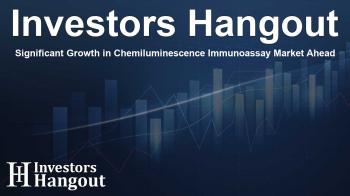Significant Growth in Chemiluminescence Immunoassay Market Ahead

Overview of the Chemiluminescence Immunoassay Market
The demand for chemiluminescence immunoassays (CLIAs) is on the rise, reflecting a growing global focus on advanced diagnostic tools. These sophisticated tests play a crucial role in diagnosing a range of conditions, from chronic diseases to infectious agents. The chemiluminescence immunoassay market was valued at USD 11.76 billion and is anticipated to reach USD 17.72 billion within a few years, forecasting a robust growth rate of 4.68% from 2024 to 2032.
Technological Advancements Driving Market Growth
One of the primary catalysts for this upward trend is the continuous innovation in diagnostic technologies. As healthcare evolves, the push towards enhancing the early detection of various diseases cannot be overstated. High-sensitivity assays are particularly favored for their quick results and wide applicability across fields such as oncology, endocrinology, and infectious disease testing. The increasing introduction of multiplex capabilities is also noteworthy, allowing for simultaneous multi-biomarker testing which accelerates throughput while enhancing cost efficiency.
Rising Incidence of Chronic Diseases
The global surge in chronic illnesses, including diabetes, cardiovascular diseases, and cancer, has created a pressing need for effective diagnostic testing. Changes in demographics, notably the growing geriatric population, further compound this need. As patients live longer, the emphasis on preventive healthcare and personalized medicine becomes vital, reinforcing the position of CLIAs in clinical settings.
Regional Market Dynamics
In North America, particularly in the United States, significant investments in healthcare infrastructure and a trend towards automation in clinical laboratories have made this region a leader in the chemiluminescence immunoassay market. The projected market value reached USD 3.66 billion recently. As healthcare systems emphasize cost-effective and efficient testing solutions, the U.S. market is expected to maintain its momentum well into the next decade.
Segment Analysis: Unpacking the Market
The market segmentation reveals that consumables are the most significant revenue generator, accounting for over 65% due to the ongoing necessity for assay kits, reagents, and quality control products. This environmental aspect of repeat purchases is particularly pronounced in hospital and clinical laboratory settings, where consistency in tests regarding hormones and infectious diseases is critical.
Sample Type Insights
Blood samples remain dominant in market share, primarily due to their diagnostic reliability and compatibility with various assay systems. Nevertheless, the urine sample sector is poised for accelerated growth, driven by the rising demand for non-invasive diagnostics and an expanding test menu addressing renal and metabolic disorders.
Major Stakeholders in the Market
The competitive landscape comprises key players like F. Hoffmann-La Roche AG, Danaher Corporation, Siemens Healthineers, Abbott Laboratories, and others. Each company brings forward distinct innovations and products contributing to a rapidly evolving market space.
Investment and Growth Potential
With favorable reimbursement policies and strategic government support enhancing the diagnostic infrastructure in developed economies, these market players are well-positioned to benefit. Keeping pace with technological advancements and maintaining a focus on quality will be crucial for these companies aiming for long-term success.
Challenges and Considerations
Despite optimistic growth forecasts, the market does face several hurdles. Issues such as regulatory changes and regulatory approvals may impact the speed at which new technologies can be adopted. Additionally, ensuring consistent quality in testing amidst rapid technological changes is paramount for maintaining trust and efficacy in this sector.
Frequently Asked Questions
What is the chemiluminescence immunoassay market valuation?
The chemiluminescence immunoassay market was valued at USD 11.76 billion and is projected to reach USD 17.72 billion by 2032.
What are the main drivers of market growth?
The key drivers include technological advancements in diagnostics, rising chronic disease incidence, and the increasing need for early disease detection.
Which segment holds the largest market share?
In 2023, consumables led the market, contributing to 65.7% of total revenue due to ongoing requirements for various assay products.
What role do major players play in this market?
Major players like Roche and Abbott are crucial as they drive innovation and maintain high standards of diagnostic tools and technologies.
How is the regional market structure in this sector?
North America predominates the market, while the Asia Pacific region is seen as the fastest-growing market due to increased healthcare access and technological adoption.
About The Author
Contact Evelyn Baker privately here. Or send an email with ATTN: Evelyn Baker as the subject to contact@investorshangout.com.
About Investors Hangout
Investors Hangout is a leading online stock forum for financial discussion and learning, offering a wide range of free tools and resources. It draws in traders of all levels, who exchange market knowledge, investigate trading tactics, and keep an eye on industry developments in real time. Featuring financial articles, stock message boards, quotes, charts, company profiles, and live news updates. Through cooperative learning and a wealth of informational resources, it helps users from novices creating their first portfolios to experts honing their techniques. Join Investors Hangout today: https://investorshangout.com/
The content of this article is based on factual, publicly available information and does not represent legal, financial, or investment advice. Investors Hangout does not offer financial advice, and the author is not a licensed financial advisor. Consult a qualified advisor before making any financial or investment decisions based on this article. This article should not be considered advice to purchase, sell, or hold any securities or other investments. If any of the material provided here is inaccurate, please contact us for corrections.

